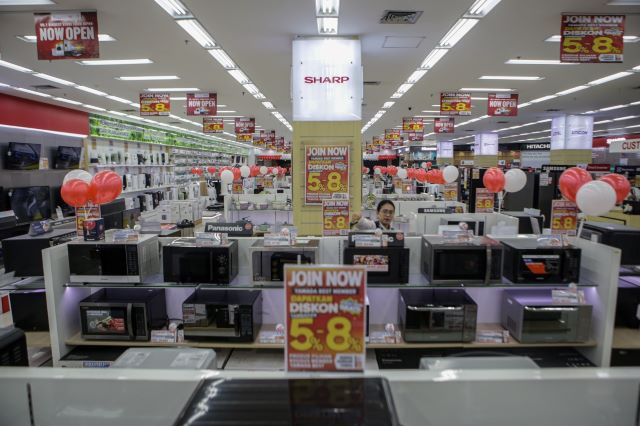Popular Reads
Top Results
Can't find what you're looking for?
View all search resultsPopular Reads
Top Results
Can't find what you're looking for?
View all search resultsDisrupting retail from the inside out
Building new ventures requires a greater degree of risk, an adherence to agile principles of rapid experimentation with real customers, and a willingness to work at speed while also protecting your overall brand.
Change text size
Gift Premium Articles
to Anyone
 Market expansion: Retail electronics shop employees arrange products during the opening of Yamada Best in Summarecon Mall in Serpong, South Tangerang city, Banten, on July 11, 2023. The shop is the eighth outlet of the Japanese electronics chain in Indonesia. (Antara/Fauzan)
Market expansion: Retail electronics shop employees arrange products during the opening of Yamada Best in Summarecon Mall in Serpong, South Tangerang city, Banten, on July 11, 2023. The shop is the eighth outlet of the Japanese electronics chain in Indonesia. (Antara/Fauzan)
R
etail is facing a tumultuous period. Consumer preferences and expectations are rapidly evolving, supply chains are struggling, and the lines between digital and physical are becoming less distinct. All of these factors are presenting significant obstacles to growth and profitability in the retail industry.
Whether you are a physical retailer, an omnichannel player, or an entirely digital storefront, you’re probably assessing your primary operations and noticing a disparity between their growth potential and your long-term scale ambitions.
Our research clearly points to continued market volatility for core retailing; however, we do see successful players emerging by moving beyond their core retailing roots and investing wisely in new “Engine 2” businesses. In fact, we believe that these new engines of growth could account for up to 50 percent of leading retailer profits by 2030.
Building new businesses and capturing this growth is not without risk. Your organization has been developed to manage a retail business—asking it to pivot to an entirely different endeavor presents numerous challenges, and getting it wrong could cause the new venture to fail and can impose greater strain on your core business.
Ramifications can include financial and human resource distraction, potential damage to your brand reputation, and a decline in employee morale, among other pitfalls. It is critical that you adopt a fresh approach to building Engine 2 businesses.
Bain & Company has identified three of the most critical moves necessary to enable success with Engine 2 business building during our time working with dozens of leading retailers around the globe: leverage your strategic assets; approach with an investor’s mindset; and adopt an agile, entrepreneurial working approach.
The first question is where you should play. As a retailer, you are sitting on numerous strategic assets—from your customer base to your supply chain—each of which can position you to win in new markets.
Take advertising as an example. Bain's research indicates that 59 percent of advertisers see unique benefits in retail media networks, and 60 percent believe stricter data privacy regulations will increase their importance. In 2022, Amazon’s advertising business alone earned US$37.7 billion, including a 19 percent Q4 year-over-year increase, with significantly higher operating margins than either its core or its Amazon Web Services (AWS) businesses. Notably, over half of Amazon’s 2022 net sales originated from segments beyond its traditional online and physical stores.
Clearly understanding customer needs and how your brand can extend to solve those needs will help you learn which assets to leverage. Consider a Southeast Asian quick-serve restaurant that recognized its traditional business couldn’t fulfill its growth ambitions. To expand, they initiated a deep dive into how customers viewed their brand and what made them unique, and used this to identify and prioritize new Engine 2 opportunities, including moving into various consumer product categories.
When evaluating and choosing which opportunities to pursue and how to manage the business-building effort, consider an investor’s mindset. This means analyzing the new business not just as a stand-alone entity but by how it may also benefit your core. Once you decide to pursue the opportunity, it means maintaining strict vigilance on key performance indicators and allocating funds as you see the venture meet its goals. If the venture starts to waver, make hard decisions around either pivoting or shutting it down.
Bain worked with a large Asia-Pacific e-commerce platform and identified their extensive user data as a valuable resource that enabled them to optimize their platform's revenue through improved upselling and cross-selling while creating a new revenue stream by offering consumer insights and market data to brands in the market. Throughout the journey, the company had clear performance goals in mind and only scaled its investment as success became apparent.
Finally, building new ventures is not the same as managing your day-to-day business. It requires a greater degree of risk, an adherence to agile principles of rapid experimentation with real customers, and a willingness to work at speed while also protecting your overall brand.
This typically means setting up new teams that are dedicated to the cause and can work independently from the core, certainly in the early phases of growth. It may also mean partnering with others who have capabilities that complement your own.
One example of this is a leading Asia-Pacific food retailer. To meet growth goals, they realized the need to venture beyond traditional food shopping into new categories and consumer occasions. Aware that these new businesses differed from their core, they built entrepreneurial teams to fast-track market entry and partnered with entities that were much nimbler than their traditional vendors.
They strategically structured the interaction between these teams and the core business, balancing core protection while ensuring the new teams could operate efficiently and rapidly reach their market with sufficient independence.
The rising significance of Engine 2 expansion, required by both established retailers and digital natives, reflects the transformation of modern retail. It aims to make retailer economics sustainable for the long term. While moving beyond the core business involves challenges, retailers should not undervalue the potential of their existing assets as a foundation for future profitability, and they should recognize that a playbook exists to succeed in these new endeavors.
***
Michael Egan is an expert partner and coleader of the Asia-Pacific Business Building (Next) practice at Bain & Company based in Bangkok. Shyam Unnikrishnan is a partner at Bain & Company based in Bengaluru, India.










